Photos: Drive Your Tractor to School Day in Elba

Photos by Debra Reilly.



Photos by Debra Reilly.



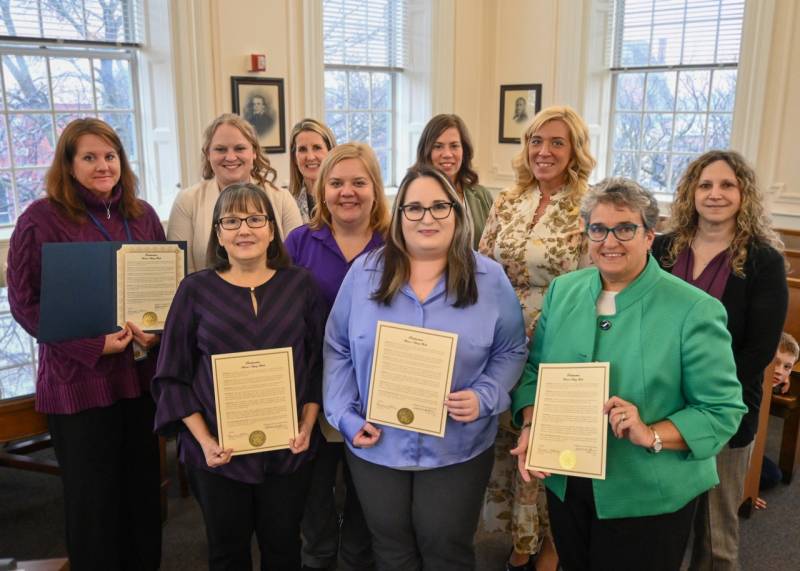
American women of every race, social stratum and ethnic background have made historic contributions to the growth and strength of our nation in countless recorded and unrecorded ways.
And so begins the proclamation that Genesee County's Legislature presented to a group of county women leaders Wednesday as symbolic support and awareness of the contributions made by women to society over the years.
The proclamation continues:
WHEREAS, American women have played and continue to play a critical economic, cultural, and social role in every sphere of the life of the Nation by constituting a significant portion of the labor force working inside and outside of the home, and
WHEREAS, American women were particularly important in the establishment of early charitable, humanitarian, and cultural institutions in our Nation, and
WHEREAS, American women have been leaders, not only in securing their own rights of suffrage and equal opportunity, but also in the abolitionist movement, the emancipation movement, the industrial labor movement, the civil rights movement, and especially the peace movement, which creates a fairer and just society for all, and
WHEREAS, each department within Genesee County includes influential women whose dedication, expertise, and leadership continue to strengthen and empower women by, demonstrating resilience, innovation, and commitment to excellence across all sectors.
Now, therefore, be it RESOLVED, that the Genesee County Legislature resoundingly embraces Women’s History Month. Their continuous contributions made to Genesee County captures the spirit of women’s determination and clear, forward thinking by demonstrating creativity, courage and forging career paths for women of all levels of society.
BE IT FURTHER RESOLVED, the Genesee County Legislature proclaims March 2025 as “Women’s History Month”. A month to take notice and appreciate the hard work women have done, and continue to do.
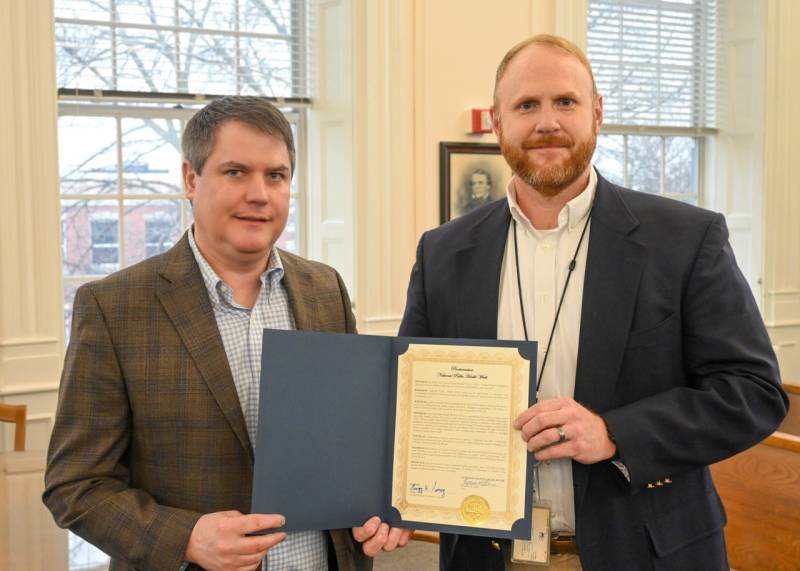
With a theme of "It Starts Here," this year's recognition of National Public Health Week placed emphasis on the importance of "making a difference in our homes, communities, and state."
Genesee County legislators took a few moments during their Legislature meeting Wednesday to underscore that importance with a proclamation for the contributions of public health professionals and highlight important health issues that impact local communities.
Legislator Gregg Torrey read the citation for the upcoming week in April, which stated in part:
WHEREAS, public health initiatives, including chronic disease prevention, communicable disease prevention, environmental health, health education, emergency preparedness, and efforts to address health disparities, play a crucial role in improving quality of life; and
WHEREAS, National Public Health Week provides an opportunity for residents to learn about key public health concerns and success stories that are essential to building a healthy community. These efforts include immunization programs, nutrition education, maternal and child health programs, safe housing initiatives through the Lead Poisoning Prevention Program, mental health promotion, substance use prevention, disease surveillance, rabies prevention through vaccination clinics, smoking and vaping education, and strengthening community resilience through emergency preparedness; and
WHEREAS, collaboration between government agencies, healthcare providers, community organizations, businesses, and individuals is essential to addressing public health challenges and building a healthier future for all; and
WHEREAS, the residents of Genesee County recognize the essential role public health plays in their everyday lives, and we commend the dedication of public health professionals, first responders, and community partners who work to protect and promote the well-being of all.
Now, therefore, be it RESOLVED, that the Genesee County Legislature hereby proclaims April 7-13, 2025, as Public Health Week in Genesee County and encourages all residents to participate in activities that promote health and wellness in our community.

A former chief operating officer for Western Region Off-Track Betting Corp. will receive $550,000 in a settlement stemming from a lawsuit he filed against the corporation in August 2021.
Michael Nolan alleged the victim of retaliation because he raised concerns about some corporation practices, such as health insurance for board members, the distribution of tickets to sporting events, misuse of funds, and improperly responding to Freedom of Information Law requests from reporters.
He was fired on Dec. 18, 2020.
In his initial filing of the suit, he sought $14.5 million -- $4.5 million for violating his First Amendment rights, another $4.5 million for breaking the state’s Civil Service Law, and an additional $5.5 million for emotional pain and suffering.
According to court documents, the case was settled through mediation on March 17 pending WROTB board approval.
Nolan began his career with WROTB in 2011 and was promoted to chief operating officer in 2017.
On Thursday, the board agreed to pay the settlement with $150,000 cash and an insurance policy covering the other $400,000.
Press Release:
The Genesee County Youth Bureau sponsored the 36th Annual Youth Conference at Genesee Community College on March 20.
This conference is offered on an annual basis to local seventh- and eighth-grade students in Genesee and Orleans County in an effort to address pertinent social issues of interest to middle school-aged youth. There were 340 seventh-and eighth-grade students in attendance.
This year we focused on promoting and fostering healthy relationships, mental well-being, and how social media affects one’s mental health.
Our interactive keynote speaker, Logan Taylor of Y.B.Normal?, spoke on the importance of respecting differences, having healthy boundaries, and the significance of coping skills. His presentation titled “You Matter” emphasized the importance of having a mental health routine and being the best version of yourself. Logan highlighted several important skills throughout his speech including leadership, critical thinking, teamwork, empathy, adaptability, and problem solving.
A total of 22 different workshops were offered to students. These workshops included a variety of human service organizations from Genesee County. The workshops were tailored to be interesting, engaging, and hands-on while addressing the theme of the conference. Topics addressed in the workshops included, Self-Defense and Personal Safety, Social Media Awareness and Online Safety, Mechatronics, Building Confidence Through Geocaching, Musical Theatre and Public Speaking, Healthy Relationships and Empowerment, and many more.
Members of the Youth Conference Committee are extremely grateful to the workshop presenters who volunteered their time to educate our area seventh and eighth graders. We are also grateful to the following businesses/organizations that provided discounts or donations for the conference…Genesee Community College, GCEDC, and Subway.
For more information on the annual Genesee County Youth Conference or to find out how you can participate in the next event, call the Genesee County Youth Bureau at 585-344-3960.

Press Release:
CAN-USA Sports is also excited to announce the return of Xtreme International Ice Racing on Saturday, March 29 at 7 p.m. at the David McCarthy Memorial Ice Arena presented by Casella Waste Systems, O-at-ka Milk Products, Batavia Downs & Hotel, and Geico Local Batavia Office.
XiiR (Xtreme International Ice Racing) is a motorcycle racing tour...ON ICE! Man and machine going from 0-60mph in under 3 seconds, with speedway bikes and quads that are modified to compete on an indoor ice arena. There are over 2000 metal studs added to the tires and there are no brakes. It is the fastest sport on ice and one of the fastest sports in the world.
The event will be making its third appearance in Batavia and each year’s event sold out at the McCarthy Ice Arena so get your tickets early online at www.mccarthyicearena.com or in person at the rink located at 22 Evans Street Batavia.

Press Release:
The Batavia Muckdogs are excited to announce their first five signings of the 2025 season. Batavia's first five players including two returners from the 2024 season, twin brothers, and a talented new face.
- James Bolton - catcher
- Tyler Castrataro - infielder
- Gavin Chandler - left-handed pitcher
- George Creighton - left-handed pitcher
- Jay Creighton - right-handed pitcher
The Muckdogs finished 2024 with their best win percentage in franchise history (.802) and posting an incredible 34-8 record as they finished with the #1 overall seed record in the West Division for the 3rd straight season.
James Bolton is a 6’2 junior catcher from SUNY Cortland. A native of Webster, New York, Bolton enters his second season with the Batavia Muckdogs. Last season with Batavia, Bolton was a reliable hitter leading the team with a .380 batting average, and an on-base percentage at .473. He recorded 30 hits and 25 RBIs. Currently at Cortland he has a batting average of .667.
Tyler Castrataro is a 5’10 freshman infielder from Mahopac, currently playing at Hofstra University. A talented hitter, he is off to a strong start in his college career, batting .308 with 4 home runs. In high school, Tyler was a standout player, hitting over .400 as both a junior and senior, he was also ranked the third best shortstop in New York State in the 2024 Perfect Game rankings.
Gavin Chandler is a 6’2 left-handed starting pitcher from Bevill State Community College. From Alabaster, AL, Chandler is entering his second season with the Batavia Muckdogs. Last summer, he let the Muckdogs in innings pitched with 42.2 innings recording nine game starts.
George Creighton is a 5’10 sophomore left-handed pitcher from Somers, currently attending Lackawanna College. He transferred from the University of Scranton and has continued to develop his skills on the mound. Last summer, he played for the Glen Falls Dragons.
Jay Creighton is a 5’11 first-year right-handed pitcher from Somers, currently attending Lackawanna College. In his first three appearances on the mound, he has made an immediate impact posting scoreless innings and recording four strike outs.
The Muckdogs finished in first place during the regular season for the third season in a row in 2024. Batavia finished with a franchise record .802-win percentage posting an incredible 34-8 record. The record setting season was cut short in the PGCBL Western Conference Championship game as the Muckdogs fell to Elmira.
“Last season we enjoyed so much success on and off the field in the community and I am so grateful and proud of what this team did here in Batavia. I know Skip Martinez can’t wait to get the Muckdogs back on the field in 2025 and bring this city a championship,” said Owner Robbie Nichols.
CAN-USA Sports & the Batavia Muckdogs are excited to welcome a new addition to their staff as Alicia McCarvill will take over as the teams Assistant General Manager. Alicia was hired after completing her internship with CAN-USA Sports property (Elmira Pioneers) last summer. While at SUNY Cortland, she worked in event operations for the Men’s and Women’s Ice Hockey teams. For the past year and a half, she has worked in social media and graphic design for 1616, a program founded by two-time Stanely Cup Champion Andrew Ladd and his wife Brandy that focuses on mental and physical health in youth hockey.
If you have not bought season tickets, make sure to get them by calling their offices at 585-524-2260 or email Marc Witt, General Manager, mwitt.canusa@gmail.com. Season tickets start at just $99!
Submitted photos.

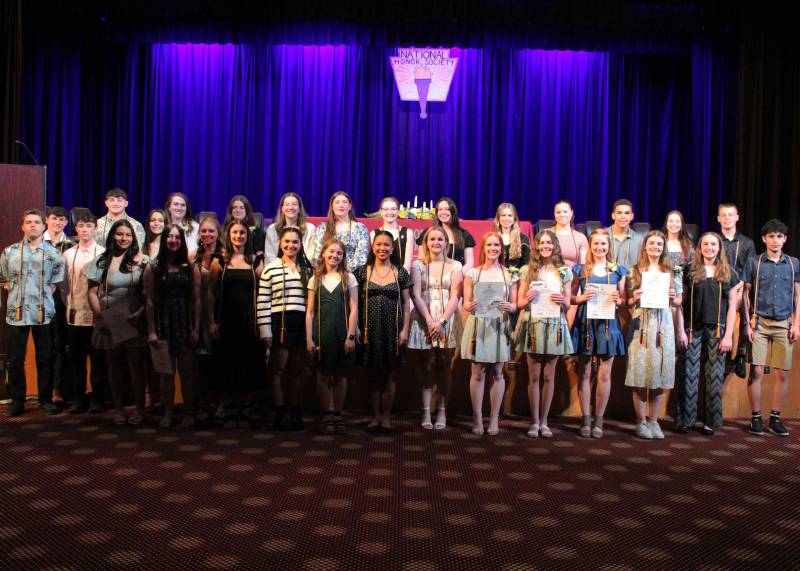
Press Release:
The Byron-Bergen chapter of the National Honor Society (NHS) welcomed 11 new student members to their distinguished company on March 19, 2025. The ceremony also honored the three latest inductees to the Byron-Bergen Alumni Hall of Fame: Scott Crosier (1982), James DeBottis (2001), and the late Kevin Heinzerling (1982).
The event began with a welcome and congratulations from District Superintendent Patrick McGee and Jr./Sr. High School Principal Paul Hazard. McGee then presented Heinzerling’s award to his daughter, who spoke on his behalf.
Heinzerling graduated from Byron-Bergen Central Schools in 1982 where he was a member of the Varsity Swim Team and worked for Harris Wilcox Auctions. After graduation, joined the United States Marines Corp where he became a combat veteran after which he joined the Air Force Reserves. He also worked for Wegmans, NYS Corrections, and Millers Millworks Inc. He remained an active part of the Byron-Bergen community until his death in 2024.
The traditional National Honor Society candle-lighting ceremony followed. It acknowledges the high standards of knowledge, character, leadership, service, and scholarship students in NHS must exhibit. The new members were called individually to receive their honor, and then the group took the NHS pledge.
The ceremony was followed by the inductions of Crosier and DeBottis. Neither were able to attend in person. DeBottis’ sister, Christina Navratil, read a speech and accepted the award on his behalf.
DeBottis graduated from Byron-Bergen in 2001 where he participated in Varsity baseball, basketball, cross-country, ski club, and Student Council. After graduation, he attended Bismarck State College, Arizona State University, and served in the armed forces. Despite not living locally since 2018, DeBottis remains connected to the District through his parents, Jamie and Sharon DeBottis whom he visits regularly and reconnects with friends and family. He currently lives in Georgia with his wife Nicole and children Jackson and Olivia.
Scott M. Crosier graduated from Byron-Bergen in 1982 where he participated in Varsity Swim Team and band. After graduation, he earned an Associates Degree in Mortuary Science and Bachelor’s Degree in Criminal Justice. Crosier worked in law enforcement and served in the Bergen Fire Department for over 30 years. He is currently the Executive Director of Flower City Pickers and is a Safety & Health Officer with the Webster Fire Department and Fire Investigator for Monroe County Fire Bureau.
National Honor Society membership not only recognizes students for their accomplishments but also challenges them to develop further through active involvement in school activities and community service. The organization has chapters in all 50 states, Canada, and beyond.



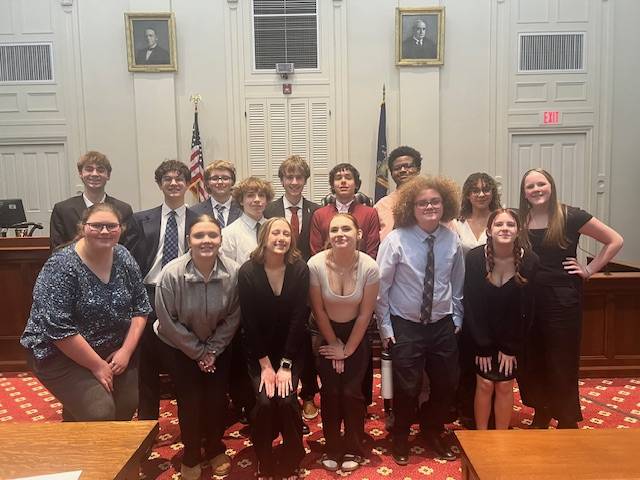
Batavia High School has a long history of success in the annual GLOW Region Mock Trial Competition, so it's no surprise the school's team won at finals again on Wednesday in Albion.
BHS beat Le Roy Jr./Sr. High School.
This year’s case, Leyton Manns v. Sandy Townes, centered on a timely libel lawsuit involving AI deepfakes.
In the fictional scenario, a student was accused of creating AI-generated content placing a school Superintendent in a false light. They had recently cut funding for the computer science club. The Superintendent, who was running for public office, lost the election and sued the student, Sandy Townes, for damages.
The team now advances to the regional competition.
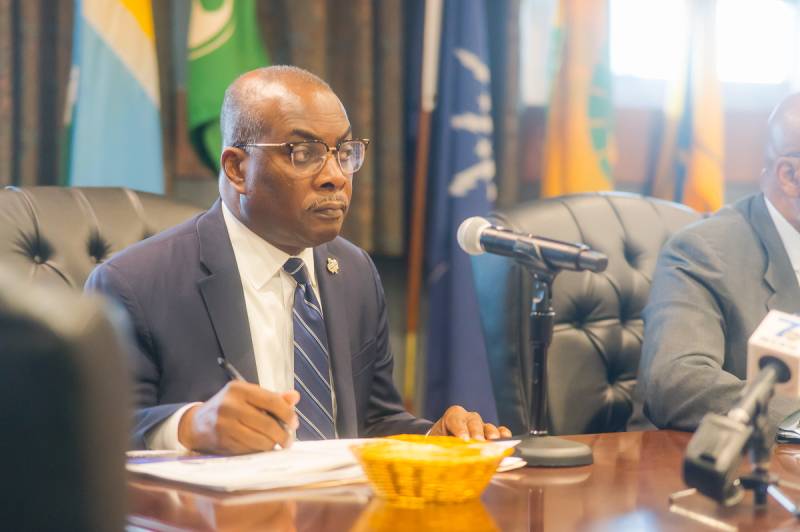
Byron Brown, president and CEO of Western Regional Off-Track Betting, is optimistic that the corporation's lobbying efforts will lead to legislation that reduces the tax OTB pays to the state from 49% to 44%.
That would amount, at current cash flow, in an estimated $4.5 million in additional revenue, Brown said.
The language for adjustment will be part of the Assembly's version of the 2025-26 budget bill. The Senate produces its own budget bill, and then the two chambers meet to negotiate a final budget bill.
"We feel good that we've done everything that we could do, that we got a good audience from the governor's office, the Assembly and the Senate, and we are hopeful that when the negotiations are concluded, that our requests will be part of the budget," Brown said.
The additional revenue will help the corporation on multiple fronts, Brown said, and those initiatives were part of the pitch to state legislators to approve the request.
"We explained that it was a matter of equity and fairness that would give us the ability to increase distributions to 17 member municipalities in Western New York, it would give us the ability to right size the salaries of our employees, and also to address the very high cost of family health care for our employees," Brown said.
Health insurance costs seem to be a top priority for OTB executives.
Currently, a family health insurance plan is $3,325 monthly for an OTB employee. If hired after Jan. 1, 2012, the employee contribution is 72 percent, or $2,394. Employees hired before that date pay only 5% of the premium.
The OTB would also be able to set aside some money to expand the hotel.
"(The hotel expansion project) projected to produce significantly more revenue for Western Regional off track betting Corporation, which would give us the ability to, again, not just increase our distributions to municipalities, but also increase the amount of money that we provide to the state of New York," Brown said.
In November, the board voted to delay a planned expansion of the hotel because of increased costs. The estimated cost provided by architects was $16 million and $16.5 million, which is about $4 million more than the original cost estimate.
The $4.5 million retained by OTB, if passed, is .0000018% of an anticipated $250 billion budget.

Angelina Pellegrino is at it again, and she’s looking for fellow spring cleaners, donors, and volunteers able to help out with her fifth annual yard sale to benefit Habitat for Humanity.
Pellegrino, a city resident and recipient of a Habitat home, has been throwing the yearly yard sale party on her own as one way to pay forward her gratitude for having been part of the nonprofit’s program. So, she, in turn, hosts the sale at the residence that she and Habitat staff worked on to make her home dreams a reality for her own family.
“The sale starts Friday, May 16th, through Sunday, May 18th, from 9 a.m. to 5 p.m. As always, all proceeds go directly to the next family,” she said. “Now that everyone will begin to spring clean, please consider donating your items to this fabulous benefit. We accept items such as clothing, shoes, housewares, household items, books, etc. Any and every donation is greatly appreciated.”
Items may be dropped off any time on the front porch of 150 State St., Batavia, or pickups can be arranged (except for large items such as chairs, tables, etc.), she said. Those larger items, including end tables, bikes, TVs, can be dropped off at her home from April 22 through May 14, when storage will be available.
“This year we are desperately looking for volunteers to help set up on Thursday, May 15. That is the day we mostly need as many hands on deck to get it all organized. We are also looking for volunteers to help with the sale itself,” she said. “Whether you are a retiree, or a student that needs to put in volunteer hours, or someone who works at a business that allows a day to volunteer for an organization, we would so appreciate that.”
There’s some added fun this year of face painting for kids, with design choices for a $5 donation that will go to Habitat for Humanity. If you’re artistic, Pellegrino is also looking for some people to help out with the face painting activity, which is scheduled from noon to 2 p.m. Saturday and Sunday, May 17 and 18 during that sale weekend.
“I urge everyone to help make this year great, as this is a wonderful program right in our community,” she said. “Please reach out to me, Angelina Pellegrino, any time via text or phone call at 585-356-4867 with any questions regarding drop-offs, pickups or volunteering.”

An overload of phosphorous — a nonmetallic chemical element that becomes a waxy solid material that glows in the dark at room temperature — has gained the attention of the Genesee County Soil & Water Conservation District, Senior Field Manager Jared Elliott says.
Elliott reviewed a five-year study at Oak Orchard Creek with county legislators earlier this month, and the county Legislature, in turn, approved $173,851 in funding toward the project and an additional staff intern position.
Legislators approved funding of $151,891 and $21,960 to support the staff position during their meeting Wednesday, for the total to be paid in regular installments through Dec. 31.
“We're working with Orleans County and SUNY Brockport. The goal is to collect data, analyze the creek some more, and potentially get a watershed management plan in place for that area. Oak Orchard is extremely impaired with phosphorus, and we need to find out where that's coming from so we can do a plan,” Elliott said during his annual report review earlier this month. “Some of it's probably from point sources. There's a lot of wastewater treatment facilities. There's municipal plants, and then the Nortera facility and the U.S. chips and facilities in Oakfield. Some of it's agriculture. Some of it's natural. The watershed could just be high and phosphorus coming out of the bedrock.
“We can narrow it down between a study and some modeling. The plan that we're going to work on is going to be probably a nine-element plan, which really focuses on, it ends up focusing on agriculture and supports grants to help with the agricultural sources, because the point source is something that's already regulated, so there's already a mechanism to reduce that. And agriculture is kind of low-hanging fruit in those areas, as far as something we can actually have an impact on,” Elliott said. “The other component there is with the solar farms that are going to be in that area, we're going to be kind of finding out how that's going to impact the hydrology and different things in that watershed, too.”
Other areas of focus for the agency have been to introduce its hydroseeding program into more municipalities, he said. According to his annual report, the District provides technical assistance to municipalities and landowners with financial support from the Finger Lakes-Lake Ontario Watershed Protection Alliance.
Hydroseeding is a method of planting grass and other crops using water, seed, fertilizer, and mulch sprayed onto the soil surface using specialized equipment, often for erosion control and quick vegetation establishment.
This Alliance funding is available to the District annually, is split between technical and financial assistance, and is a consistent funding source to support staff time, supplies, and training. In 2024, the District hydroseeded projects for the towns of Alabama, Batavia, Byron, Darien, LeRoy, Pavilion, Pembroke, and Genesee County. Approximately 13 acres of disturbed soil were stabilized with the hydroseeder.
“It grows a little bit every year. We work with new towns. We do more acreage. That's really been a point of emphasis, and that's opened the door to grant projects with a lot of these towns,” he said. “So we have a culvert replacement project scheduled for this year with Le Roy; we're talking to the town of Alabama about helping them replace their salt storage. So this hydro seeding program with the machine that the county helped us buy is kind of opening those things up for other non-ag work in the county. We do a lot of work for the county too.”
The District’s workload is increasing significantly in 2025 with several new grant projects and an added Japanese knotweed treatment program, he said in his report. Revenue sources have been steadily increasing recently, and the agency currently has no annual costs for the facilities that are used, because the U.S. Department of Agriculture currently pays rent on the office space occupied by the District.
However, this agreement could change with the cuts to the federal government, which would have budget implications for the District, he said.
“So I wouldn't expect our budget from the state to go down necessarily. We've seen fairly steady increases of the last four or five years, and I would expect that to continue for expenses. We're not really planning any major changes trying to maintain that five full-time staff right now, so we would see expenses climbing slightly just to accommodate gaining staff experience and insurance costs,” he said. “And then the only real concern that I have moving forward is we are co-located with the federal government. There's a lot of uncertainty about our office space. There's talks of reorganization and a lot of things potentially happening. So there could be a scenario where we would have to be looking for office space to lease something, but that's really our only concern, budget-wise.”
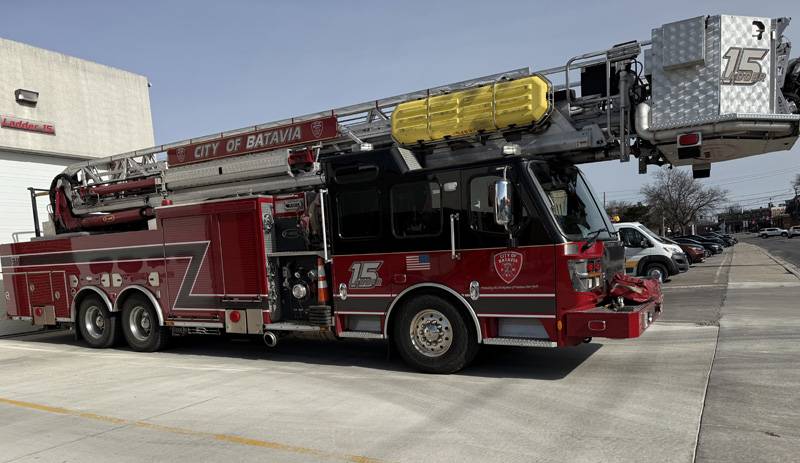
If you were a volunteer fireman in the early 1800s, you also had to own and bring your leather bucket to every fire. As a homeowner, you must have a bucket of water at your front door in case of a fire. A bucket brigade would be used to put out a fire. People would line up and hand a bucket down the line to the last person, who would throw the water on the fire.
A way to alert volunteers was to use a wooden ratchet. The homeowner whose house was on fire would bang the ratchet to sound the alarm. Each ratchet had a distinctive sound, so the location of the fire could easily be identified.
If we go back to 1837, we would have seen fire engines made of wood pulled by men. The volunteers would fill the tank at the nearest cistern. One man held the hose at the fire while the others pumped the water.
The first volunteer fire department in Batavia lasted until 1865. The clang would notify the volunteer of an alarm from a belfry. If you were a volunteer, you would leave your job, wear a red shirt, and run to the fire. The types of alarms used throughout our history were the iron triangle church bell, factory steam whistle, electrically operated siren, fire alarm box signals (one is on display at the entrance of our fire department on Evans Street), a telephone operator, and today, by calling 911.
In 1916, all six volunteer fire companies that served the village were disbanded.
As a result, in 1916, Batavia set up a semi-paid fire department with six men on full-time duty, each receiving $60 a month. Twelve men were on call for $.12 an hour, and William H. McBride, the Fire Chief, earned $1,000 yearly. The single company served the city for five years. In November 1921, the voters approved a proposal to increase the department to twelve full-time men plus a fire chief. The men were stationed in two firehouses on either side of the train tracks.
The first fire headquarters was on Court Street in a building previously owned by the Richmons and the Hooks. It served as Fire Headquarters until moving into a remodeled Municipal Building at 3 West Main Street in 1948. The second station was on Ellicott St in the Durham building at 305-307 Ellicott Street. This building was leased to the city as the second fire station. In 1946, the building was sold to the Wortzman family, who needed the space for their furniture business. A new building was constructed at 43 Ellicott Street and served as Fire Station 2.
In 1974, the City Council discussed building a new fire headquarters building. The new concrete structure, built by Louis Viele Construction Company, was on Evans Street. In 1978, the new fire department was opened. It had offices for the Chief, the Assistant Fire Chief, and the Duty Officers at the front of the building, with dormitory facilities, a kitchen, and a recreation area behind. The fire equipment was housed in the garage. Paramedic service began in May 1986.
In 2009, the city discontinued the fire department’s ambulance service.
Today, the City of Batavia Fire Department comprises 38 members, including 28 Firefighters, 4 Captains, 4 Lieutenants, a Chief, and a Senior Typist.
The early fire companies in Batavia, along with their volunteers, established the foundation for our well-equipped fire department. Today, our fire department and the nearby volunteer fire companies continue to dedicate themselves to keeping the citizens of Genesee County safe from the tragedies of fire.
The materials used for this article are from "The History of the City of Batavia" (1993) by Ruth M. McEvoy.

Demolition began on Wednesday the Town of Pembroke's Highway Department garage.
The town is building a new $7.2 million garage is funded by $1.5 million in reserves and $5.7 million in bonds.
CORRECTION: While the board approved a $7.2 million expenditure for the garage, the bids came in significantly lower than the anticipated cost. The garage will cost about $5 million, according to Supervisor Thomas C. Schneider Jr. Schneider said, "The new garage bays will be nearly twice the length of the old bays and the project includes new restroom and breakroom facilities for the Town Highway Crew."
He also provided the rendering below.

Submitted photos.




Sr. Emergency Dispatcher John W. Spencer retired from the Genesee County Sheriff's Office on Wednesday after 18 1/2 years of service.
He was honored with a walkout ceremony by his colleagues.
Photos by Steve Robinson.
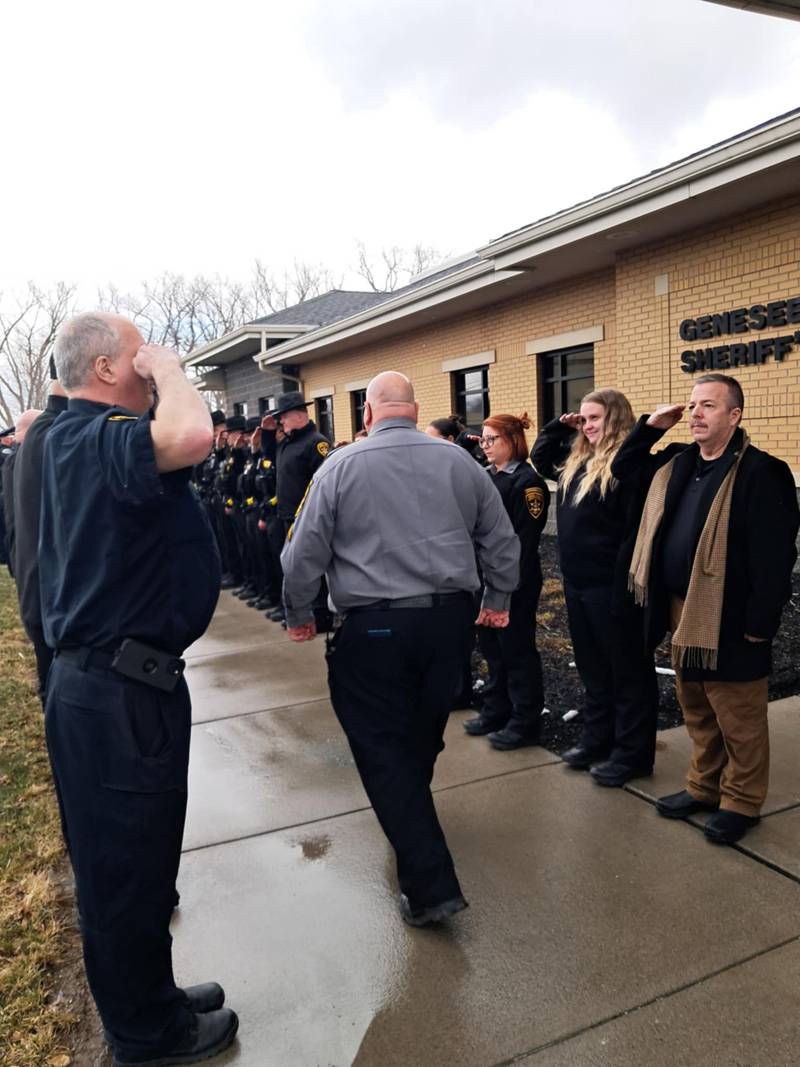


Press Release:
Eleven seniors from Batavia High School will compete for the title of “Mr. Batavia” at the 12th annual competition, which will be held on Friday, April 4, at 7 p.m. in the Frank E. Owen Auditorium at Batavia High School.
Each contestant represents a local organization. The 1st place winner will receive 50% of the profit from ticket sales and donations to go to their chosen organization. The 2nd and 3rd place winners each receive 25% of the profits for their chosen organizations. Mr. Batavia has raised and donated $43,052 since 2013.
The 2025 contestants are:
- Cooper Banser: Crossroads House
- Jeremiah Childs: The Neri Family through Reece's Rainbow
- Kahler Evans: Bella's Bumbas
- Greyson Fix: The Ricky Palermo Foundation
- Will Fulton: Genesee Cancer Assistance
- Cooper Konieczny: Volunteers for Animals
- Anthony Kopper: Suicide Prevention of Genesee County
- Marcus Nichols: Habitat for Humanity
- Gavynn Trippany: Roswell Cancer Center
- Myles Wahr: Muscular Dystrophy Association
- Matt Wittmeyer: All Babies Cherished
Hostesses for the evening’s event include: Ava Anderson and Mia Pellegrino. Event choreographers and backstage managers include: Lily Emerson and Bridget Taggart.
Additional members of the Mr. Batavia Committee include: Maddy Bellamy, Allie Bisnett, Brooke Callahan, Hannah Carney, Ally Crater, Bella DeVay, Trishelle Gibson, London Graham, Faith Guiste, Isabella Hutchinson, Kassandra Kesler, Kelsey Kirkwood, Jaimin Macdonald, Kayla Richenberg, Teagyn Thomas, Payton Vickery, and Ally Wormley.
Tickets are $10 each and will be available for students to purchase during school lunches the week of March 31 and at the door for the community.
Lisa Robinson, Mr. Batavia's advisor, would like to thank the Batavia City School Foundation for its help and support in collecting and distributing funds to local organizations.
Additional thanks to: Charles Men Shop, Main St. Pizza, Zach Korzelius at Geico Insurance, LP Graphics in LeRoy, Extreme Streetwear, Beverly's Flowers and Gifts, and the students and staff at BHS. We would also like to extend a heartfelt thank you to all the organizations represented at the show and their work on behalf of our community.
You can follow along with the Mr. Batavia competition on Instagram at https://www.instagram.com/mr.batavia, and the hashtag #mrb25.


Press Release:
The Genesee County Economic Development Center (GCEDC) board of directors will consider an initial resolution at its March 27 meeting for Batavia Cold Storage, LLC for a 7,040 sq ft facility on three acres at the Genesee Valley Agri-Business Park in the town of Batavia.
The $800,000 investment will create a cold storage facility to manufacture ice to be bagged and stored for distribution to local companies. The project will create two full-time equivalent positions with an estimated annual salary range between $26,000 and $52,000.
Batavia Cold Storage, LLC is requesting a sales tax exemption estimated at $28,729, a mortgage tax exemption estimated at $7,200, and a property tax abatement estimated at $65,717 based on the incremental increase in assessed value via a new traditional 10-year PILOT. The project is estimated to generate $917,882 in local fiscal impacts, including payroll and tax revenues, for an estimated $12 local benefit for every $1 of requested incentives.
If the proposed project application is advanced, a public hearing will be scheduled in the town of Batavia.
The GCEDC board of directors will also consider a supplemental initial resolution for Appletree Acres, LLC. The company is proposing to add a 20,000 square-foot expansion to an existing 50,000 square-foot warehouse in the Apple Tree Acres corporate park. A smaller version of the project was previously considered in December 2024.
The new $1.237 million investment would create four full-time equivalent positions with an estimated annual salary range between $45,000 and $65,000 plus benefits.
Appletree Acres, LLC is requesting a sales tax exemption estimated at $58,800 and a property tax abatement estimated at $213,336 based on the incremental increase in assessed value generated by the expansion. The project is estimated to generate $3.1 million in local fiscal impacts, including payroll and tax revenues, for an estimated $14 local benefit for every $1 of requested incentives.
If the revised project application is advanced, a supplemental public hearing will be scheduled in the town of Bergen.
The GCEDC board meeting will be on Thursday, March 27 at 4 p.m. at the MedTech Center’s Innovation Zone, 99 MedTech Drive, Batavia.
Meeting materials and links to a live stream/on-demand recording of the meeting is available at www.gcedc.com.
A Data Center in the Midst of Alabama’s Cornfields? “Gift” or Trojan Horse?
The greatest bone of contention about mega industries like data centers on the STAMP site was, and remains, the call for a new Environmental Impact Statement or EIS - a document required by federal law that outlines the potential environmental impacts of a proposed project. The only one issued was back in 2012 before STAMP had even broken ground at the site. Since 2021, when more specifics about the types of mega-industrial developments STAMP was considering for the site became known, the Chief of the Tonawanda Seneca and concerned citizen groups have repeatedly called for a new EIS and SEQR - a law requiring state and local agencies to consider environmental impacts when making discretionary decisions. They argue that, as the agency involved in a project’s development and in line to profit from it, it is a potential conflict of interest for GCEDC to have oversight of the environmental stipulations informing the EIS and the SEQR. GCEDC stands to gain tens of millions of dollars in fees from the data company they choose.
Not Just Any Old Data Center. By any contemporary standard, an updated EIS would seem to be a reasonable request. Data centers, in particular, have changed a lot since 2012. Massive data centers needed for AI applications are currently being built at sites around the world. As noted in recent Wall Street Journal, New York Times, MIT articles data centers consume the most energy of all high tech industries, needing tons of electricity and water to cool stacks upon stacks of on-site computers. Approval of proposals like Project Double Reed by the GCEDC would give the go ahead for a mega center that fuels high end AI computing chips by drawing 250-350 MW of power. Supported by New York State taxpayer dollars to the astounding tune of over 472 million dollars in subsidies, this boils downs to a subsidy of 3.9 million for each of the 122 jobs that Double Reed promises to bring. As a point of comparison, according to GCEDC’s website, their support of light manufacturing at AppleTree Acres near the rural hamlet of Bergen will generate 60 new full time jobs with a salary range of $45 to 65,000 annually plus benefits. GCEDC’s report states this was launched with only 42 million in taxpayer dollars, about 1/ 10th of what is at stake with Double Reed at STAMP. a center that is laden with pertinent ethical questions regarding its potential effect on the neighboring Tonawanda Seneca Nation, the Wildlife Refuge and Oak Orchard Watershed.
Whom would the servers serve? In a paper that uncovers “how utilities are forcing ratepayers to fund discounted rates for data centers,” Ari Peskoe, Director of Harvard University’s Electricity Law Projects observes that “Artificial intelligence is one technology driving the number and size of data centers which don’t need subsidized energy rates if they are already receiving other incentives from a state to locate. We’re all paying for the energy costs of the world’s wealthiest corporations.” In effect, a mega data center at the STAMP site would require enough energy to power a city of 50,000 people in the Alabama cornfields. Placed next to the Wildlife Refuge and Tonawanda Seneca Nation, a massive data center of this type would forever alter the character of the region and bring a host of potential consequences.
What the Trojan Horse could bring: The public might well consider what happens if the computers in a data center overheat, which they are known to do. They can cause a huge fire and explosion. Local EMS services and the Alabama fire station would be hard pressed to deal with an emergency of this magnitude. What happens if the new substation with electrical power that a data center would use to cool their super fast and hot computer systems went down during an extreme weather event? For their part, a data center would stand to lose millions of dollars every hour, so they have generators on site along with 20 to 30 thousand gallons of diesel fuel. There are 40 known cancer-causing organic substances, including polycyclic aromatic hydrocarbons (PAHs), benzene, formaldehyde, acetaldehyde, acrolein, and 1, 3-butadiene released in the burning of diesel fuel, which is classified as "carcinogenic to humans" by the International Agency for Research on Cancer (IARC), which links its emissions to lung cancer and bladder cancer. OSHA warns that workers exposed to diesel exhaust face the potential risk of health effects ranging from irritation of the eyes and nose, headaches and nausea, to respiratory disease and lung cancer. Based on warnings about health effects attached to the release of diesel fuel in the air, what the purported “gift” of a mega- industrial Trojan Horse of a data center could release on wildlife as well as humans would be equally toxic.
Due Deliberation? Fast Tracking the Vote on the Double Reed: Notwithstanding these weighty public concerns and their implications, on Feb 28, less than a month after the Feb 3 hearing, GCEDC posted a 116 page “Staff Report’ on their website addressing some of the objections raised at the public hearing of Feb 3 that generated a large such an outcry of public concern. Dismissing Tonawanda Seneca Chief Roger Hill and the public’s call for a new EIS and SEQR, in an interview with Mark Masse published on March 3 in the Batavian Masse tentatively stated he “felt” and/or “anticipated” Project Double Reed Data Center would meet the environmental thresholds of the 2012 EIS. “So the facility that they're going to be building (in STAMP) is going to be brand new. It'll have all of the lessons learned from previous projects […} So we anticipate it to fit within the parameters of what was analyzed for the EIS, and we would anticipate them to propose and follow through on any potential mitigation that we would suggest for noise or that the town board planning board may suggest for noise.” However, what is not clear who the ultimate user of a data center would be, as Double Reed would build the facility and lease the server capacity to one or more technology companies.
Within a matters of days - between the time GCEDC’s “staff report” came out on Feb 28 and the Executive Meeting of GCEDC held on March 5 (when it was recommended that their staff bring the vote on the Double Reed Project to the GCEDC Board at a meeting the following day on March 6) - a flurry of 210 comments were sent to GCEDC board members. Among the comments was a letter from the lawyer for the TSN protesting the fast tracking of the vote on approval of Double Reed and stating that the Tonawanda Seneca Nation needed more than a couple days before it could meet with Masse or GCEDC to discuss Double Reed, especially since the actual tenant for the site was still unknown.
On March 6 GCEDC committee members met to vote on the proposal to move forward with Double Reed at the STAMP site. Leaving work early once again, over a dozen, Genesee, Orleans, Niagara and Monroe County residents went to great lengths to attend the meeting. Complying, once again, to the rules of order that no one but committee members could speak, concerned citizens stood silently against the back wall by the table where five board members cast their vote on behalf of welcoming Double Reed, a project that would affect generations of Tonawanda Seneca and other human and environmental communities in the region. The protesters held placards that expressed both their objections to the data center as well as the way the vote was fast tracked without respecting to the requests of Tonawanda Seneca Nation. Shortly after the meeting was convened, a frustrated mother wheeling a baby carriage with a young child called out members of the board for the potential harm to the region and future generations.
Learning from Past Mistakes Infamously known for years as “the Silo” the Batavia Mall on Main Street stands as a testament to what many generations of local people have agreed was an unfortunate, short-sided decision made in the 1970s to capitalize on urban renewal funds. A city block featuring century-old downtown buildings, historic structures and heritage architecture on Batavia’s Main Street was demolished to make way for the Genesee Country Mall and City Centre. The character of the city was irrevocably altered and the mall has been bleeding taxpayer and tenants’ money ever since. Documenting the consequences of this decision, in 1991 Bill Kauffman, the popular author of “Dispatches from the Muckdog Gazette” wrote: "The city fathers rushed headlong into urban renewal, whereby the federal government paid Batavia to knock down its past {…]all of it Batavia tore out - literally - its five-block heart and filled the cavity with a ghastly mall, a dull gray sprawling oasis in a desert of parking spaces. The mall was a colossal failure, but it succeeded in destroying the last vestiges of our home-run economy.”
The Iroquois Wildlife Refuge and the ancestral lands of the Tonawanda Seneca Nation make this region unique. There is still time to RETHINK STAMP and ask whether a Mega Industrial project like a Data Center at STAMP is a “gift” to our region or a dull gray sprawling Trojan Horse misallocating millions of taxpayer dollars and releasing a swarm of lawsuits, ethical, social, health and environmental problems.
Christine F. Zinni, PhD
Cultural Historian
https://thereader.mitpress.mit.edu/the-staggering-ecological-impacts-of-computation-and-the-clo

New York State is sticking with a plan to require school districts to begin the conversation to electric buses in 2035.
Starting that year, school districts will be prohibited from purchasing gas or diesel buses.
Le Roy Central School District is working to delay buying its first electric bus as long as possible.
"Most communities are not in this category of wanting EV buses, and I think we're in that boat," Superintendent Merritt Holly said. "With our plan, we're trying to set ourselves up so that we don't have any pressure until prices come down and infrastructure is in place. We're buying ourselves time with our fleet that we have right now so that we're not forced into buying something until we're ready to do it."
District voters recently approved a plan, on a vote of 61-7, to purchase more buses at a cost not to exceed $700,000, with $200,000 from the 2019 capital reserve fund.
The district will purchase:
Currently, electric school buses cost from $400,000 to $500,000 each.
Holly said the mandates are beyond the district's control.
"What we can control is waiting around with our fleet to make sure that when the time comes, when the infrastructure is there, and when costs are coming down -- because right now, these are not popular decisions inside many communities. It's not inside of Le Roy."
Copyright © 2008-2022 The Batavian. All Rights Reserved. Privacy Policy | Terms of Service